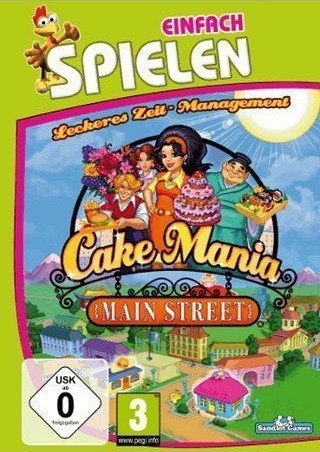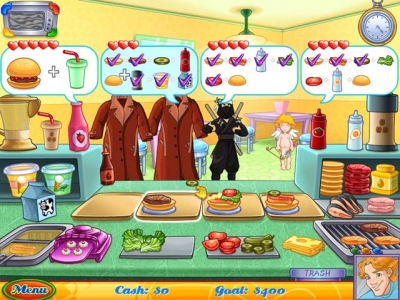game format:
Join Jill and I as we try to take back her hometown that's being overrun by a mall and putting shops out of business.
time management | arcadepuzzles: none
playtime: 5 hours | difficulty: easy
developer / publisher: Sandlot Games

Cake Mania Main Street Download
links:Official site | Buy this gamegame brief: Take a trip back to Jill Evans'™ hometown of Bakersfield in Cake Mania Main Street™, the highly anticipated fourth chapter in one of the most popular time management series of all-time! Help Jill and her closest friends earn enough money to revitalize Main Street by opening, managing, and upgrading four unique downtown shops and building must-see tourist attractions. (Official website)
 review: Cake Mania returns with its fourth instalment – Main Street, bringing back Jill Evans, who makes the best cakes in the universe, her husband Jack, and her friends Risha, the city girl, and Tiny, the ex-sumo wrestler.
review: Cake Mania returns with its fourth instalment – Main Street, bringing back Jill Evans, who makes the best cakes in the universe, her husband Jack, and her friends Risha, the city girl, and Tiny, the ex-sumo wrestler. As usual, an upstart mall, Baker’s Corner, has run out the quaint mom-and-pop shops from Bakersfield’s Main Street, which leads to the setup of Operation OSDBFRBRMSATAWSSCFBC - umm, yes. That’s “Operation Save Downtown Bakersfield From Ruin By Revitalising Main Street and Attracting Tourists, All While Secretly Stealing Customers From Baker’s Corner”, which sums up the aim of the game.
So, getting on with that noble mission, we start with the Grand Reopening of the Evans Bakery. The game format remains the same - Jill serving her clients with cakes, frostings and toppings. She takes orders by phone too, though each level rarely logs more than one call.
 But thereafter the game breaks away from the confines of its name, and allows the player to purchase, upgrade and run three more types of shops: Jack’s Burger Barn, Risha’s Flower Shop and Sumo’s Sushi. Each shop has 25 levels, adding up to a 100 crazy levels of running around baking cakes, making burgers, selling bouquets and wrapping sushi. This is as good as offers get – four for the price of one!
But thereafter the game breaks away from the confines of its name, and allows the player to purchase, upgrade and run three more types of shops: Jack’s Burger Barn, Risha’s Flower Shop and Sumo’s Sushi. Each shop has 25 levels, adding up to a 100 crazy levels of running around baking cakes, making burgers, selling bouquets and wrapping sushi. This is as good as offers get – four for the price of one!The Flower Shop follows the same format as the Bakery, replacing cakes with bouquets loaded with wrappings, ribbons and knick-knacks. Burger Barn and Sumo’s Sushi have a different format – the player is ‘behind the table’ making the dishes, similar to 2007's Burger Island.
A map of Bakersfield shows the position and condition of the shops, the town’s attractions, and the number of tourists. Each shop has a daily income, which accumulates to allow purchase of shop improvements, which in turn increases its daily income. Half of all daily earnings from the shops go to the town, which is used to build attractions like the Bakersfield Arch, the Giant Ferris Wheel-O-Fun and fountains and statues for the benefit of tourists (and of course, the town). Trophies are awarded for completing various milestones of the game.
After each successful level, the Bakery and Flower Shop allow purchase and resale of equipment and upgrades. The Burger Barn and Sumo’s Sushi allow purchase of new recipes (a vast collection) and two items, both for pacifying customers.
The clientele ranges from aliens to vampires to pirates and sundry corny types, including a spaced-out hippy who wants tacos but can be sold, well, ANYTHING. Some clients affect other clients either to the gamers’ advantage or against – Super-Matt freezes his neighbours, ninjas black them out, mafia-man steals money, vampires turn others into vampires, and an arrogant chef turns patrons into hot dogs, changing their orders, often leading to massive wastage, and consequently, negative marking. It’s not really a bad thing - it makes an otherwise standard game unpredictable and challenging.
A big annoyance for me was that Jill and Risha carry only one item at a time, which resulted in a LOT of walking back and forth, reducing productivity, tiring the eyes, and being boring in general. Burger Barn and Sumo’s Sushi are super-efficient though: there’s no unnecessary movement, wrong ingredients cannot be added and fried things don’t get burned, so there’s zero wastage.
Cake Mania starts each shop segment with tutorials that are simple to grasp even for first-timers either to the series, or the genre. The game is easy too: 99 levels took me only one attempt to reach the goal, and never more than 2 – 3 attempts to reach Superstar for the (surprisingly few) demanding levels. Level 24 of Sumo’s Sushi remained unconquered: despite 10 retries, I failed to get past 1700-odd versus a Superstar target of 2000. But overall, it’s fun without frustration, and full marks for keeping it that way.
The art is average: the comic book format is common, the intro screens are gaudy, and the actual game screens have nothing new to offer. The music is average too; mostly up-tempo beats thumping up the urgency, except for the cringe-inducing electronica-oriental theme of Sumo’s Sushi. The game has many voice-overs, and while stereotypical, these did make the intro segments more interesting.
One thing that grated on my nerves – and this seems to be a trend across time management games nowadays – is the ‘big is bad and hostile, small is sweet and all heart’ message that kept getting pounded across. Maybe because I’m a city girl through-and-through, never having lived in a small town, I disagree with this regressive anti-mall, anti-retail chain, anti-multiplex, anti-big hotel, anti-organised sector philosophy.
Cake Mania Main Street Walkthrough 3
While I’m sure market research supports following through with this theme again and again, I find it alarming that gamers today, especially girls who are a key audience, are in favour of this in-your-face back to the basics propaganda, which, frankly, is in complete contradiction to the reality. Jill is ambitious enough to take on a large shopping mall and beat it to the ground. She buys shops and entertainment venues across town, builds her own statue as a tourist attraction, rakes in the moolah selling new and improved items from level to level, and yet remains aggressively derisive of the very quality she displays in achieving her goal – sheer business acumen that identifies and capitalises on money-making opportunities. Is there really any difference between the ultimate aim of a mom-and-pop shop and the biggest retail chains?The game tries to get us familiar with Jill’s friends too. Jack is sweet and affectionate but daft. Risha is smart and no-nonsense, and brings most of the humour to the game with her snarky remarks.
Tiny’s saga is tragic and bizarre in equal parts – an Octozilla (mutant octopus) drowned his village and he was forced to become a sumo wrestler to make ends meet, and then he defeated someone, who is now hunting him down via ninjas. All this has unfortunately but expectedly scrambled his brains and he now revels in romantic matches between shrimps and crabs and squids, all the while nursing a deathly fear of fugu (wikipedia), a dish made from the poisonous pufferfish.
Then there’s this unnecessary track of Jill’s hinted-at pregnancy, covering the entire gamut of side-effects from morning sickness to mood swings to craving for strange foods. Unnecessary, because till the end she displays no baby-bump, Jack remains absurdly clueless, and there is no update on the situation in the final wrap-up. I suppose we’ll see in Episode 5.
I was honestly disappointed that Cake Mania: Main Street did not endeavour to break any new ground in terms of game-play or storylines or production values, given that it’s one of the leaders of the genre and hence lends itself to big expectations. It’s a quick, formula package – a product of the suited-up retail business the game ironically keeps bashing, and lacks the much-touted heart.
PS: Cake Mobile offers the option to play the game on the cell-phone, taking a step forward in techno-terms, but I remain old-school for now.
g@mrgrl rating: 3/5